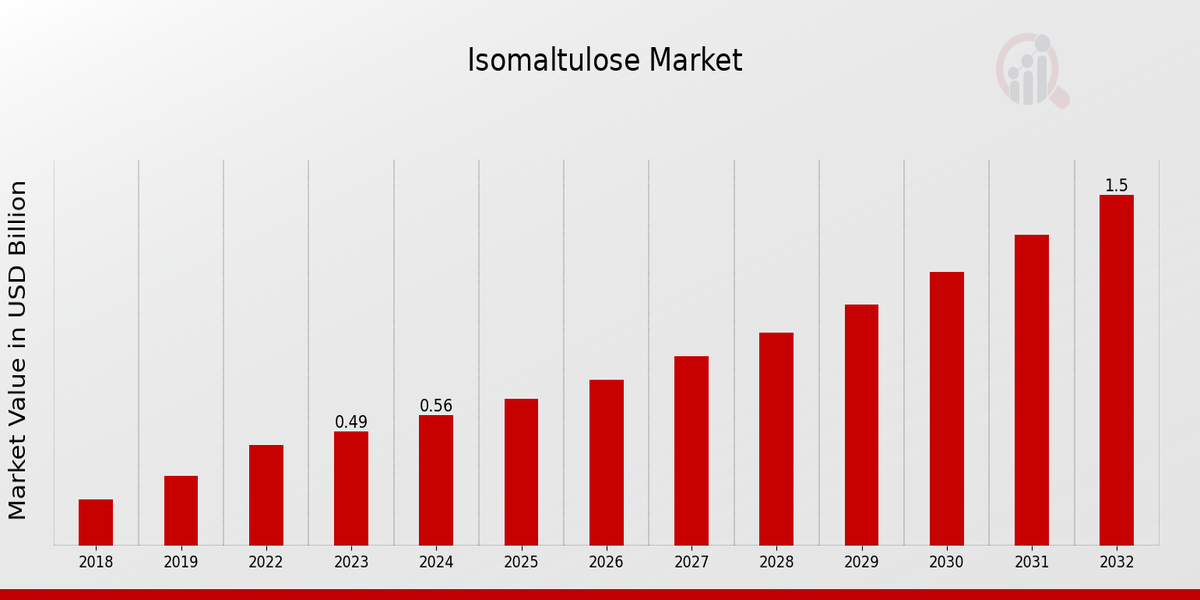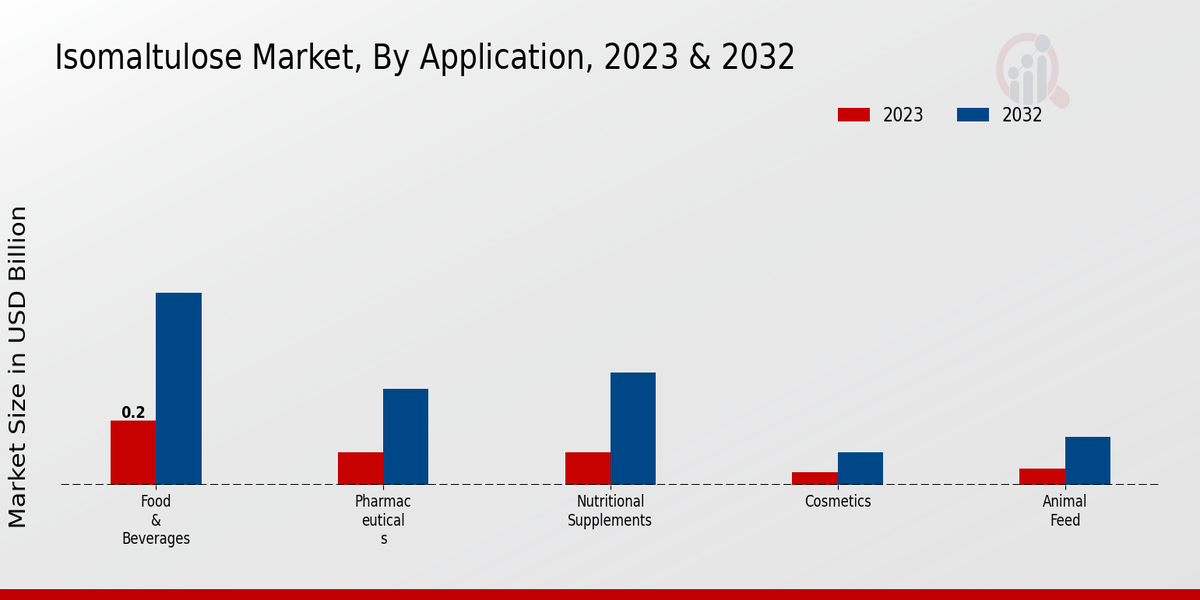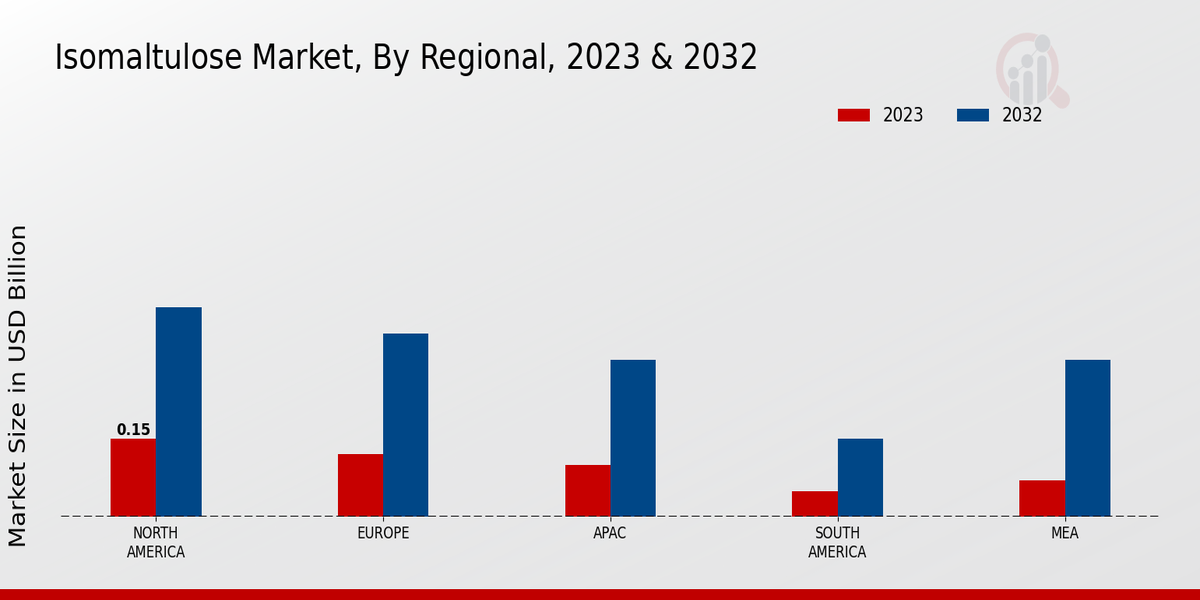Global Isomaltulose Market Overview
Isomaltulose Market Size was estimated at 0.43 (USD Billion) in 2022. The Isomaltulose Market Industry is expected to grow from 0.49(USD Billion) in 2023 to 1.5 (USD Billion) by 2032. The Isomaltulose Market CAGR (growth rate) is expected to be around 13.18% during the forecast period (2024 - 2032).

Source Primary Research, Secondary Research, MRFR Database and Analyst Review
Key Isomaltulose Market Trends Highlighted
The Isomaltulose Market is experiencing notable growth driven by several key factors. Increasing health awareness among consumers is pushing the demand for low-glycemic alternatives to sugar. As more people seek healthier dietary options, isomaltulose is emerging as a preferred choice due to its better digestion and lower impact on blood sugar levels. Furthermore, the rise in obesity-related health issues is motivating manufacturers to explore healthier sweetening options in food and beverage products. This health trend is combined with the growing interest in functional foods, where isomaltulose plays a vital role in offering nutritional benefits alongside sweetness.
Opportunities in the Isomaltulose Market are expanding as industries recognize the potential of this ingredient for a variety of applications. The growth of the sports nutrition sector is particularly significant as athletes and fitness enthusiasts seek products that provide sustained energy release without rapid spikes in blood sugar. Additionally, there is a rising trend towards clean label products, pushing manufacturers to utilize natural ingredients like isomaltulose. This opens avenues for product innovation and customization, allowing companies to cater to diverse consumer preferences while maximizing their market reach. Recent trends indicate a marked shift towards health-centric products, with isomaltulose gaining traction in various sectors, including bakery, dairy, and beverages.
The increasing adoption of vegan and plant-based diets is also enhancing the appeal of isomaltulose, as it aligns with the clean-label movement. Moreover, advancements in processing technologies and growing demand for sustainable and natural ingredients are further augmenting market dynamics. In this evolving landscape, businesses are adapting to consumer needs by exploring new formulations and enhancing product offerings to maintain competitiveness in the Isomaltulose Market.
Isomaltulose Market Drivers
Growing Demand for Low-Calorie Sweeteners
The increasing health consciousness among consumers has propelled the demand for low-calorie sweeteners, making them a prominent driver in the Isomaltulose Market Industry. As obesity and lifestyle-related diseases become more prevalent, consumers are actively seeking healthier alternatives to traditional sugars. Isomaltulose, being a natural sugar derived from beet sugar, provides a mild sweetness with low caloric value while offering additional benefits such as low glycemic index and sustained energy release.
This aligns with the trends toward healthier diets, and its adoption in various food and beverage products, including sports drinks, nutritional bars, and dietary supplements, is on the rise. Producers and manufacturers within the Isomaltulose Market are also innovating new products incorporating isomaltulose to meet these consumer demands for better health. Moreover, as government regulations increasingly restrict the use of artificial sweeteners and high-calorie sugars, the legal landscape is further supporting the growth of isomaltulose.
In recent years, the message of healthy living has permeated many aspects of society, leading to a significant shift in consumer purchasing behavior. This change has created a strong framework for the isomaltulose market, which is expected to witness accelerated growth during the forthcoming years. As more consumers embrace healthier living, the demand for isomaltulose as a premium low-calorie sweetener will likely expand.
Expansion of Functional Foods and Beverages
The rise in popularity of functional foods and beverages significantly boosts the Isomaltulose Market Industry. These products, which provide added health benefits beyond basic nutrition, often incorporate ingredients such as isomaltulose to enhance their functionality. With an increasing number of consumers prioritizing health and wellness, manufacturers are keen to formulate foods and beverages that cater to these preferences. Isomaltulose is ideal for energy products and those targeting metabolic health, making it a favorable choice for formulators.
This trend is further supported by the demand for products that promise sustained energy without the crash associated with high-sugar foods. The expansion of this segment presents robust growth potential for the isomaltulose market.
Rising Awareness of Glycemic Index
The increasing awareness about glycemic index (GI) is driving the Isomaltulose Market Industry. More consumers are recognizing the importance of low-GI foods in managing blood sugar levels, particularly for diabetic patients. Isomaltulose is naturally lower on the glycemic index compared to regular sugars, making it a suitable alternative for both health-conscious individuals and those with specific dietary requirements. As educational efforts around healthy eating continue to rise, more consumers are expected to seek out foods and beverages that utilize isomaltulose, thereby enhancing market growth.
Isomaltulose Market Segment Insights
Isomaltulose Market Application Insights
The Isomaltulose Market has shown significant potential within the Application segment, projected to be valued at 0.49 USD Billion in 2023 and expected to grow substantially over the coming decade. The key areas of this market comprise Food & Beverages, Pharmaceuticals, Nutritional Supplements, Cosmetics, and Animal Feed. Notably, the Food & Beverages category holds a majority share, valued at 0.2 USD Billion in 2023 and projected to reach 0.6 USD Billion by 2032, indicating its dominant position due to the increasing consumer preference for low-calorie sweeteners. This demand is largely driven by the rising health consciousness among consumers and the need for healthier alternatives to traditional sugars in the food industry. The Pharmaceuticals sector, valued at 0.1 USD Billion in 2023 and forecasted to grow to 0.3 USD Billion by 2032, emphasizes the growing recognition of isomaltulose for its low glycemic index, making it suitable for diabetic patients and those seeking effective weight management solutions.
Additionally, the Nutritional Supplements segment, also holding a value of 0.1 USD Billion in 2023 and expected to rise to 0.35 USD Billion by 2032, underlines its importance, particularly among fitness enthusiasts and health-focused consumers looking for energy-boosting products. The Cosmetics segment, valued at 0.04 USD Billion in 2023 with growth anticipated to 0.1 USD Billion by 2032, indicates the emerging trend of incorporating natural sweeteners and cosmetic formulations focusing on skin health, thus gaining traction in niche marketing strategies. Lastly, the Animal Feed segment stands at 0.05 USD Billion in 2023 and is expected to expand to 0.15 USD Billion by 2032, reflecting a significant growth opportunity as the demand for functional feeds that optimize animal health rises. Collectively, these insights reveal that the Isomaltulose Market segmentation illustrates a diversified growth trajectory, with individual applications catering to distinct consumer needs and preferences across multiple industries.

Source Primary Research, Secondary Research, MRFR Database and Analyst Review
Isomaltulose Market Form Insights
The Isomaltulose Market, particularly in the Form segment, demonstrates considerable growth potential as it caters to diverse consumer needs. As of 2023, the market was valued at 0.49 billion USD, with expectations of continuing expansion driven by rising health consciousness and demand for natural sweeteners. Within this segment, products primarily exist in two forms Powder and Liquid. The powdered form of isomaltulose enjoys significant popularity due to its versatility, making it suitable for various applications, from food and beverages to dietary supplements.
Meanwhile, the liquid form is gaining traction in ready-to-drink beverages and sports nutrition products, reflecting a consumer shift towards convenient nutrition solutions. These trends in the Isomaltulose Market indicate a strong preference for easily incorporated ingredients, presenting ample opportunities for businesses to innovate and enhance product offerings. The segmented nature of this market enhances its appeal, as it allows companies to target specific consumer needs, driving further market growth. Overall, the Isomaltulose Market data reflects a steady upward trajectory that underscores its relevance in the broader health and wellness landscape.
Isomaltulose Market Source Insights
The Isomaltulose Market, valued at 0.49 USD Billion in 2023, is experiencing a notable expansion driven by the diverse sources of isomaltulose. The market has shown strong growth potential, with significant contributions from both natural and synthetic sources. Natural sources, leveraging the increasing consumer preference for healthier options, mirror trends toward plant-based dietary choices and are gaining importance in the food and beverage industry. Synthetic sources also play a critical role, providing cost-effective and stable options for mass production, catering to various applications.
The segmentation within the Isomaltulose Market highlights how natural and synthetic sources serve distinct market needs and preferences, with natural sources typically reflecting a growing demand among health-conscious consumers. Continued advancements in production technology and heightened awareness of the health benefits of isomaltulose are further fueling market growth. This dynamic landscape presents opportunities for innovations tailored to both segments, enhancing the overall market statistics and strengthening the industry's future trajectory.
Isomaltulose Market End User Insights
The Isomaltulose Market, valued at 0.49 USD Billion in 2023, showcases diverse applications across various end users, driving significant growth within the industry. With Beverage Manufacturers capitalizing on isomaltulose for its low glycemic index, the demand in this segment reflects a broader trend toward healthier beverage options. Bakery Manufacturers also play a crucial role as they incorporate isomaltulose to enhance the nutritional profile of their products, appealing to health-conscious consumers. Dietary Supplement Manufacturers benefit from the ingredient’s positive impact on energy regulation, thereby supporting the ongoing health and wellness movement.
Meanwhile, the Cosmetics Manufacturers’ use of isomaltulose highlights its functional aspects, promoting skin hydration and overall product efficacy. As the Isomaltulose Market data reveals, the segmentation within this market indicates rising opportunities driven by evolving consumer preferences and an increasing focus on natural and functional ingredients. With projected market growth, these segments are poised to benefit significantly from the shift toward healthier alternatives, enabling sustainable expansion and innovation in their respective fields.
Isomaltulose Market Regional Insights
The Isomaltulose Market is experiencing robust growth across various regions, with the market valued at 0.49 USD Billion in 2023 and projected to reach 1.5 USD Billion by 2032. North America holds a majority share, valued at 0.15 USD Billion in 2023 and expected to grow to 0.4 USD Billion by 2032, reflecting strong consumer demand for low-calorie sweeteners. Europe follows closely with a market valuation of 0.12 USD Billion in 2023, anticipated to rise to 0.35 USD Billion by 2032, driven by increasing health awareness and the adoption of isomaltulose in food and beverage applications.
The APAC region is also significant, with a current value of 0.1 USD Billion, growing to 0.3 USD Billion, capitalizing on the rising trend of healthier alternatives in the growing markets. South America and MEA present smaller yet noteworthy markets, valued at 0.05 USD Billion and 0.07 USD Billion respectively, in 2023, both demonstrating potential growth due to increasing health consciousness and urbanization. Overall, the regional dynamics of the Isomaltulose Market highlight robust competition and growth opportunities driven by rising health trends and consumer preferences for natural sweeteners.

Source Primary Research, Secondary Research, MRFR Database and Analyst Review
Isomaltulose Market Key Players and Competitive Insights
The Isomaltulose Market is characterized by a diverse array of participants vying for market share while striving to innovate and respond effectively to consumer demands. Isomaltulose, known for its low glycemic index and high stability, is gaining traction as a sugar substitute in various food and beverage applications. Competitive dynamics within the market are shaped by factors such as product quality, pricing strategies, supply chain efficiency, and brand reputation. As health-conscious consumers increasingly seek alternatives to traditional sugars, companies in the isomaltulose space are focusing on promoting their products' benefits, strengthening distribution networks, and enhancing customer engagement. The market landscape is also influenced by regulatory developments and growing awareness around nutritional aspects, prompting firms to adapt their offerings accordingly.
MGP Ingredients has established a prominent position in the Isomaltulose Market through its commitment to quality and innovation. The company leverages advanced production techniques to offer isomaltulose that meets the demands of both consumers and industry players. Known for its strong emphasis on research and development, MGP Ingredients continuously invests in improving product formulations and applications, thereby increasing the versatility of isomaltulose in various sectors such as health foods, beverages, and confectioneries. The company’s robust customer service and effective marketing strategies further enhance its market presence, allowing it to cultivate lasting relationships with clients and address specific market needs efficiently. MGP Ingredients’ dedication to maintaining high standards of food safety and compliance with regulatory requirements adds to its competitive advantages, ensuring trust among consumers and partners alike.
Ingredion stands out in the Isomaltulose Market with its substantial expertise in ingredient solutions and a strong emphasis on sustainability. The company's extensive portfolio is supported by sophisticated research capabilities that focus on developing innovative isomaltulose products tailored to consumer preferences and industry standards. Ingredion's reach enables it to serve a diverse clientele across numerous markets, leveraging its strategic partnerships to enhance distribution and accessibility. The organization not only prioritizes the quality and functionality of its products but also actively engages in initiatives that promote healthier lifestyles, aligning its offerings with the evolving trends in nutrition. With a commitment to continuous improvement and responsiveness to market shifts, Ingredion is well-positioned to maintain a competitive edge in the rapidly changing landscape of the Isomaltulose Market.
Key Companies in the Isomaltulose Market Include
-
MGP Ingredients
-
Ingredion
-
Cargill
-
Fujicco
-
Tate and Lyle
-
Crown Ingredients
-
Roquette
-
Emsland Group
-
Nexira
-
Agrana
-
Mitsubishi Shokuhin
-
Naturally Sweet
-
Beneo
Isomaltulose Market Industry Developments
The Isomaltulose Market has recently seen significant developments, particularly with companies such as MGP Ingredients, Cargill, and Ingredion expanding their product offerings and market reach. There have been notable shifts in consumer preferences towards healthier alternatives, which is driving demand for isomaltulose as a low-glycemic sugar substitute. Additionally, Tate Lyle and Roquette are investing in RD to enhance the nutritional profiles of their products, tapping into the growing health-conscious demographic. Recent mergers and acquisitions, such as Mitsubishi Shokuhin’s strategic alliances to boost production capabilities, highlight a trend toward consolidation in the industry, aiming to improve supply chain efficiencies and expand market penetration. Companies like Emsland Group and Agrana are also focusing on diversifying their portfolios to align with shifting consumer trends. The overall market valuation is witnessing growth due to the increased application of isomaltulose in the food and beverage sectors, driven by health trends and innovations, thereby significantly impacting the market dynamics. With the rise of naturally sourced ingredients, businesses are increasingly recognizing the potential of isomaltulose as a key player within the broader sugar alternatives market.
Isomaltulose Market Segmentation Insights
- Isomaltulose Market Application Outlook
- Food & Beverages
- Pharmaceuticals
- Nutritional Supplements
- Cosmetics
- Animal Feed
- Isomaltulose Market Form Outlook
- Isomaltulose Market Source Outlook
- Isomaltulose Market End User Outlook
- Beverage Manufacturers
- Bakery Manufacturers
- Dietary Supplement Manufacturers
- Cosmetics Manufacturers
- Isomaltulose Market Regional Outlook
- North America
- Europe
- South America
- Asia Pacific
- Middle East and Africa
Isomaltulose Market Report Scope
| Report Attribute/Metric |
Details |
| Market Size 2022 |
0.43(USD Billion) |
| Market Size 2023 |
0.49(USD Billion) |
| Market Size 2032 |
1.5(USD Billion) |
| Compound Annual Growth Rate (CAGR) |
13.18% (2024 - 2032) |
| Report Coverage |
Revenue Forecast, Competitive Landscape, Growth Factors, and Trends |
| Base Year |
2023 |
| Market Forecast Period |
2024 - 2032 |
| Historical Data |
2019 - 2023 |
| Market Forecast Units |
USD Billion |
| Key Companies Profiled |
MGP Ingredients, Ingredion, Cargill, Fujicco, Tate and Lyle, Crown Ingredients, Roquette, Emsland Group, Nexira, Agrana, Mitsubishi Shokuhin, Naturally Sweet, Beneo |
| Segments Covered |
Application, Form, Source, End User, Regional |
| Key Market Opportunities |
Growing health-conscious consumer base, Rising demand for sugar substitutes, Increased applications in Food & Beverages, Expansion in emerging markets, Regulatory support for natural sweeteners |
| Key Market Dynamics |
Rising demand for sugar alternatives, Increasing health consciousness among consumers, Growth in functional food sector, Expansion of e-commerce channels, Regulatory support for natural ingredients |
| Countries Covered |
North America, Europe, APAC, South America, MEA |
Frequently Asked Questions (FAQ) :
The Isomaltulose Market is expected to be valued at 1.5 billion USD in 2032.
The expected CAGR for the Isomaltulose Market is 13.18% from 2024 to 2032.
North America holds the largest market share, with a value of 0.15 billion USD in 2023.
The Food & Beverages segment is projected to reach a value of 0.6 billion USD by 2032.
Major players include MGP Ingredients, Ingredion, Cargill, and Tate Lyle, among others.
The Pharmaceuticals application is expected to be valued at 0.3 billion USD by 2032.
The APAC region is projected to contribute 0.3 billion USD to the market by 2032.
The Nutritional Supplements application is expected to reach 0.35 billion USD by 2032.
The Cosmetics application is expected to grow to 0.1 billion USD by 2032 from 0.04 billion USD in 2023.
Challenges may include raw material sourcing and market competition affecting overall growth.

















